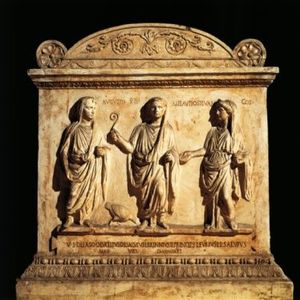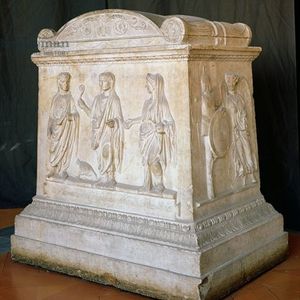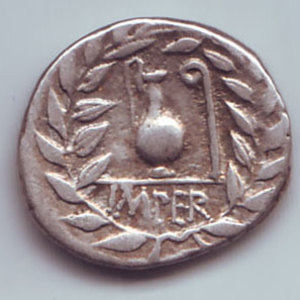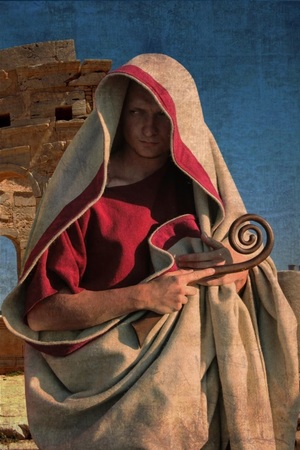Augur
Augur (lat. augures) were a type of priest in ancient Rome specialized in divination and prophecy. They were members of the Roman priestly college. Augurs performed official state divinations (the most famous of which were auspices) to predict the outcome of certain events based on natural signs and the behavior of birds (the word itself derives from the Latin words avis - bird, and gero - to behave, to act). The term "augurium" referred to the divination ceremony itself. Augurs had several distinctive attributes, including the trabea (a type of toga), the priestly staff (lituus), and a special vessel (capis) for sacrifices. The knowledge and authority of augurs were known as "ius augurium" and documented in relevant books (libri augurales).
History
Augurs emerged during the time of Romulus. Livy asserts that during the reign of Numa Pompilius, the state office of Augur was established, which was honorary and lifelong. According to the Ogulnian Law of 300 BCE, their number in ancient Rome was nine, of which five were plebeians. During Sulla's rule, their number increased to fifteen, and Caesar added one more, making it a total of sixteen members in the College of Augurs. Augurs were self-selected from within the college (cooptati). However, in 154 BCE, on the proposal of the plebeian tribune Gnaeus Domitius Ahenobarbus, the members of the college began to be elected by the Roman people. This law was repealed by Sulla in 103 BCE but reinstated in 63 BCE. In 44 BCE, Mark Antony again abolished the law, but it was reinstated by Aulus Hirtius and Gaius Vibius Pansa. After that, during the time of Augustus, the appointment of augurs was done by the emperor. The position of augur remained lifelong, and the candidacy was proposed by the two senior members of the college. The oldest member of the college was called the Master of the College (magister collegii). The election of new augurs was accompanied by celebrations.
The etymology of the word "inauguration" is also interesting, as it comes from "inauguratio." This word and the ceremony itself have their origins in the augurs. Originally, "inauguratio" referred to the blessings of the augurs and the ceremony of assuming office.
To establish the signs, the augurs would first mark out a templum (tescum) - a small space from which observations were to be made. Behind it was the area where the signs would occur. One of the augurs would use their staff to draw two lines (the first line ran from north to south - cardo, and the second line intersected the first one from east to west - decumanus) across the entire field of observation. Then, the augur would connect the ends of the lines to form a rectangle and begin the ritual of divination. The ritual took place at the designated location in the vicinity of Rome (usually on the Capitoline Hill, where there was a special place called auguraculum, or during the gathering of the centuriate comitia - on the Field of Mars), and a tent (templum minus) was set up for the ceremony.
Augurs also dealt with other issues, including political matters. An example is the election of public officials when, in 426 BCE, the question arose whether a military tribune with consular power could appoint a dictator without angering the gods. This question was brought to the augurs, who dispelled doubts on the matter. In 175 BCE, the augurs answered whether an error was made in choosing the location for military operations by the consuls. In 168 BCE, the decision of the augurs prevented the departure of the Roman army on a campaign, as the consul had to go to Gaul only with Latin allies, leaving the legions in the city because, according to the augurs' opinion, he had chosen an inauspicious day for gathering the troops.
Related topics
Pontifex, Toga, Vestal, Roman Republic, Flamin
Literature
- Augury / / Encyclopedia of Brockhaus and Efron : in 86 vols. (82 vols. and 4 supplements). - St. Petersburg, 1890-1907.
- Smorchkov A.M. Determination of the sinfulness of auspices by the Augur College // Interuniversity collection of scientific articles "Antiquity of Europe". Perm: Perm University, 1992, pp. 78-85.






